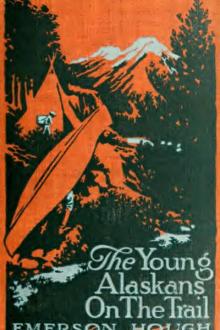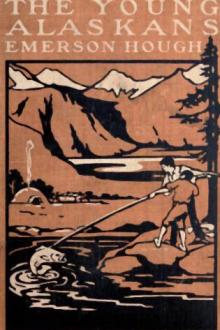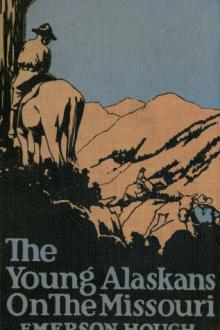Young Alaskans in the Far North by Emerson Hough (ereader android .txt) 📕

- Author: Emerson Hough
- Performer: -
Book online «Young Alaskans in the Far North by Emerson Hough (ereader android .txt) 📕». Author Emerson Hough
So sharp was the bend of the great river here that at the turn it seemed as though the river itself had come to an end or had dropped out of sight. The walls on the left seemed perhaps a trifle higher, ranging in height from one hundred to a hundred and eighty feet, the crest in places broken into crenelated turrets.
“Well,” said Rob, “this is the celebrated run of the Ramparts. I must confess I am disappointed. I think the Yukon beats this in a great many places. They may tip this off as a big attraction for tourists, but it’s too far to come for the show, in my estimation.”
John, busy charting the channel on his map, nodded his head in affirmation. “How wide do you think it is here, Rob?” he asked, and Rob was obliged to ask some of the boat officials as to that. They told him that the river was from three hundred to five hundred yards wide at this place, and that there were two great bends in the six miles of the run between the shut-in walls.
“How far is it to the Arctic Circle, Uncle Dick?” demanded Jesse of their leader when finally he came on deck after finishing his work in his state-room.
The latter rubbed his chin for a time before he could reply. “Well,” said he, “I don’t know just where it is, but it’s somewhere on ahead of Fort Good Hope, and we’ll strike Fort Good Hope now just beyond the foot of the Ramparts. We’ll say that some time in the night we’ll pass the Circle.”
“Hurrah for that!” exclaimed Rob, and the other boys also became excited.
“What does the Circle look like?” asked Jesse, with much interest.
“Well,” replied his uncle, “I don’t think it looks like anything in particular. But I think we’ll feel the bump when we run over it in the night. I can assure you of that. Also I can assure you that, once you get above it, at the end of our northern journey, you’ll see a country different from any you have seen. You hardly realize, no doubt, the great extent of this tremendous run from the Rockies to the sea.”
Meantime the boat had been continuing its progress steadily. It required about forty-five minutes to complete the run of the bolder part of the shores known as the Ramparts. Once below, there was to be seen, even in the faint midnight light, the scattered buildings of that far-northern post known as Good Hope.
The boys, with all the rest of the passengers, went ashore here and prowled about the curious old place, examining with much interest the mission school, the church, and the garden. Rob was able to make a picture of the interior of the church, putting his camera on a pile of hymn-books and making a long-time exposure.
The post trader told him later something of the history of this curious building which for some time had stood here upon the utmost borders of civilization.
“You see all the decorations and frescoes of the church, just like those in a cathedral of the Old World,” said he. “It was all done by a young priest known as Brother Antel, now gone to his rest. The church was built thirty years ago by Bishop Clute, of Little Slave Lake, who brought up Brother Antel from that lower mission. The altar is considered an astonishing thing to be found here, almost directly under the Arctic Circle.”
They all stood with their hats off in this curious and interesting structure of the Far North, hardly being able to realize that they were now so far beyond the land where such things ordinarily are seen.
“The decorations are fine and the frescoes splendid,” said Jesse to John, as they passed outside the door, “but I don’t see why Father Antel has the angels playing on the mandolin. I didn’t know they had mandolins that long ago.”
“Never mind about that, Jesse,” said Rob, reprovingly. “You mustn’t make light of anything of the kind. You must remember that these Slavie Indians, who are the only people who come here for services, are most impressed by pictures which they can see and understand. I suppose it’s all right. At any rate, it’s an astonishing thing to find such a church away up here, even if it had angels listening to an H. B. phonograph.”
The boat remained at Good Hope all too short a time to suit them, because all our young travelers were anxious to go to the top of a certain hill, from which it was said they could have a view of the Midnight Sun, which had disappeared behind the ridge of the hills back of the fort itself. Indeed, one of the crew ascended this eminence, and claimed that he had made a photograph of the Midnight Sun. Certainly, all of the boys were able to testify that it was still light at four o’clock in the morning, for they had remained up that late, eagerly prowling around through the curious and interesting scenes of the far-northern trading-post.
So wearied were they by their long experience afoot on the previous day that on the morning of July 7th they slept a little later than usual, although their total hours of rest were no more than two or three. Uncle Dick was before them on the deck this time, and reproached them very much when they appeared.
“Well, young men,” said he, “did you feel any heavy jar, or hear a dull, sickening thud, some time about half an hour or an hour ago?”
“You don’t mean that we’ve passed the Circle, do you, Uncle Dick?” queried John.
“We certainly have. I don’t know just where it was. It’s seven-thirty o’clock now, and somewhere between here and Fort Good Hope we crossed the Arctic Circle!”
“I can’t believe it!” said Rob. “Why, look, the weather is perfectly fine, and there isn’t any ice to be seen. On the other hand, there are plenty of mosquitoes. What’s more, just back at Fort Good Hope we have seen that they can raise things in their gardens. I would never have believed these things about this northern country if I had not seen them myself.”
Through the soft, mild light of the sub-Arctic morning the great steamboat churned on her north-bound way. At ten o’clock they passed an Indian village which they were told was called Chicago—no doubt named by some of the Klondikers who were practically cast away here twenty years earlier. John put it down on his map under that name, as indeed it is charted in all the authentic maps of that upper region. They were told that a good number of Indians come here to make their winter hunt.
An uneventful day, during which the boat logged a great many miles in her steady progress, was passed, until at ten o’clock they tied up at the next to the last of the Hudson’s Bay posts on the Mackenzie River, known as Arctic Red River, located at sixty-seven degrees and thirty minutes north latitude.
“Oh, look, look, fellows!” exclaimed John, as they pulled into the landing here. “Now we’re beginning to get some real stuff! I feel as though we were pretty near to the end of the world. Look yonder!”
He pointed to where, along the beach at the foot of the bluff, there lay two encampments of natives.
“Look at the difference in the boats!” exclaimed John, running to the side of the boat. “There are whale-boats with sails, something like those we saw out on the Alaska coast. What are they, Uncle Dick?”
“Those are Eskimos, my young friend,” said their leader, “and what you see there are indeed whale-boats. The Huskies come up the river this far to trade with the other Indians, and with the white men at this post. This is about as far as they come. They get their boats in trade from the whale-ships somewhere along the Arctic. As John says, this is really a curious and interesting scene that you see.
“Over yonder, I think, are the Loucheux. I don’t think they are as strong and able a class of savages as the Huskies. At least, that’s what the traders tell me.”
“Well, they’ve got wall tents, anyway,” said Jesse, who was fixing his field-glasses on the encampments. “Where did they get them? From the traders, I suppose. My, but they look ragged and poor! I shouldn’t wonder if they were about starved.”
By this time the boat was coming to her landing, and the boys hurried ashore to see what they could find in this curious and interesting encampment.
There were two trading-posts at Arctic Red River—the Hudson’s Bay Company post, and that of an independent trading company, both on top of the high bluff and reached by a stairway which ran part way up the face.
Some of the tribesmen from the encampment now hurried down to meet the boat—tall and stalwart Eskimos in fur-trimmed costumes which the boys examined with the greatest of interest and excitement, feeling as they did that now indeed they were coming into the actual North of which they had read many years before.
“Uncle Dick is right,” said Rob. “These Eskimos are bigger and stronger than any of the Indians we have seen. I don’t think the women are so bad-looking, either, although the children look awfully dirty.”
“It’s like Alaska, isn’t it?” said John. “Look at the parkies they wear, even here in the summer-time. That’s just like the way Alaska Indians and white men dress in the winter-time.”
“Well,” said Jesse, “maybe that’s the only clothes they’ve got. I’ll warrant you they have on their best, because this is the great annual holiday for them, when the Company boat comes in.”
Rob looked at his watch. “Twelve o’clock!” said he. “I can’t tell whether the sun is up yet or not, because it is so cloudy. Anyhow, we can say that we are now under the Midnight Sun, can’t we?—because here we are right among the Eskimos.”
Uncle Dick joined them after a while, laughing. “Talk about traders!” said he. “No Jew and no Arab in the world would be safe here among these Huskies! They are the stiffest traders I ever saw in my life. You can’t get them to shade their prices the least bit on earth.
“These boats,” he continued, “are crammed full of white-fox skins and all sorts of stuff—beaver, marten, and mink—and some mighty good fur at that. But those people haven’t seen any white men’s goods for at least a year, and yet they act as if they hadn’t an intention in the world of parting with their furs. Look here,” he continued, holding out his hand.
The boys bent over curiously to see what he had.
“Stone things,” said John. “What are they?”
“What they call ‘labrets,’” said his uncle, taking up one of the little articles. “They make them out of stone, don’t you see?—with a groove in the middle. If you will look close at some of these Eskimo women, or even men, you will find that they have a hole through their lower lip, and some of them wear this little ‘labret.’ Here also are some made out of walrus ivory.”
“Well, now I know what it was I saw that tall Husky had in his face awhile ago,” said John. “Something was sticking through his lower lip, and I know now it was the glass stopper of a bottle of Worcester sauce.”
Uncle Dick laughed. “Correct!” said he. “I saw the same fellow, and, now that you mention it, I gave him three dollars for that glass stopper from the bottle! I don’t suppose any one





Comments (0)